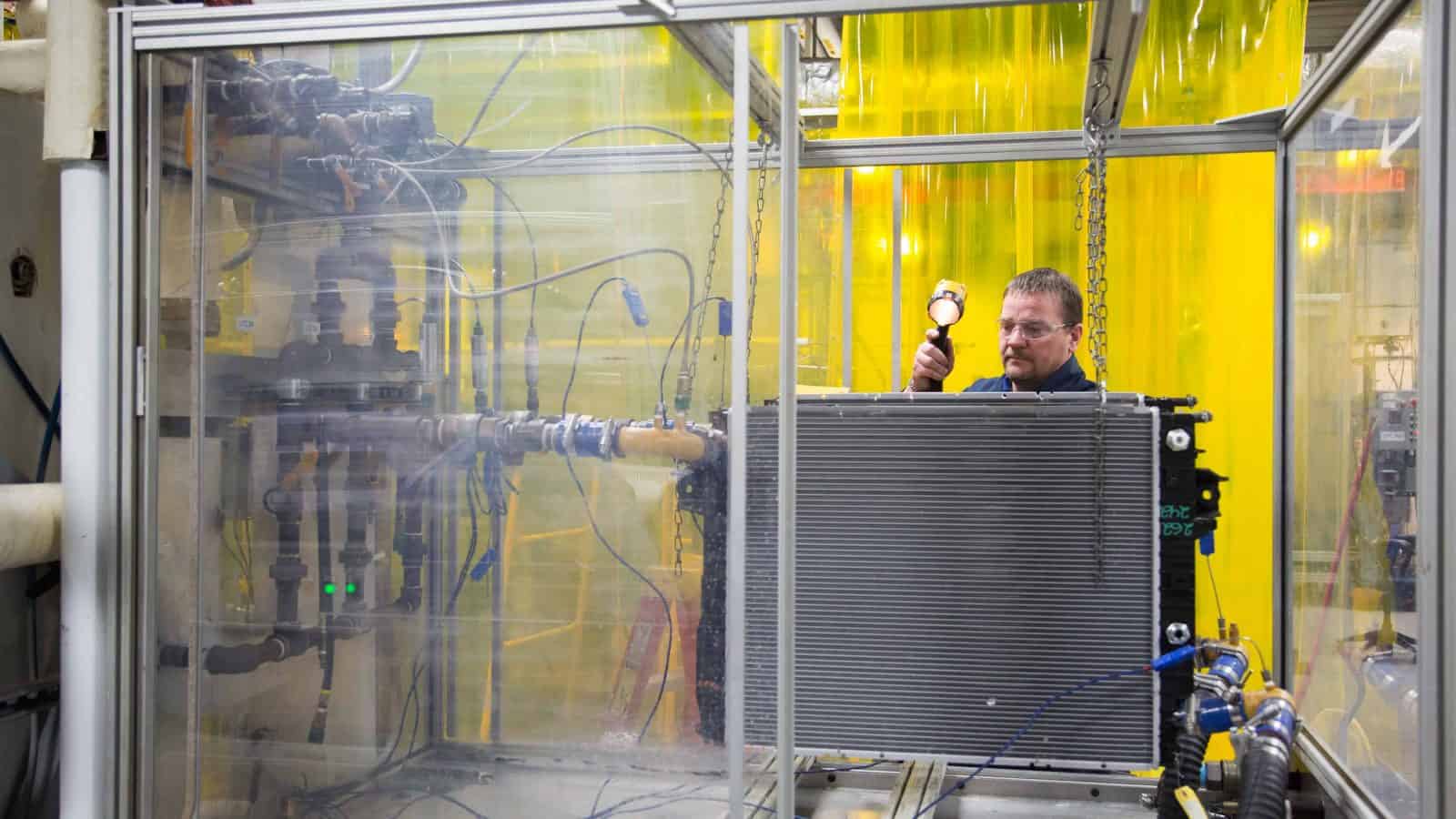New Survey: Manufacturers Want Increased Trade with Europe
New Regulations and Taxes Will Hurt Expansion
London, U.K. – As the National Association of Manufacturers’ Competing to Win Tour begins its second week of bolstering strategic alliances across Europe, the association released findings from its Q1 2023 Manufacturers’ Outlook Survey. The survey found that expanding trading opportunities with Europe is a top priority for manufacturers, with more than 77% of respondents supporting negotiating new agreements with European nations.
“At a time when democracy and free enterprise are under attack from forces around the world, America can provide the leadership needed to defend our values, our institutions and our way of life,” said NAM President and CEO Jay Timmons. “By advancing an ambitious trade agreement agenda, we can ensure that the U.S.—and not competitors like China—writes the rules for the global economy and trading system. That has been the focus of our conversations with government, association and business leaders across Europe over the past week.”
The survey also continues to illustrate the need for Washington to enact policies that support the sector’s competitiveness as businesses face record job openings and increased production and input costs.
“With geopolitical turmoil and a banking crisis injecting further uncertainty into the economy, policymakers must act with urgency on key tax, trade, permitting and regulatory proposals if they want to help manufacturers in America fend off a recession,” said Timmons.
Background: Manufacturers have called on Congress and the White House to address key tax, trade, and permitting policies in recent months and have pressed lawmakers to work across the aisle to move legislation. The NAM conducted the survey from Feb. 21 to March 7, 2023.
Key Findings:
- Of companies that are engaged in international trade, nearly two-thirds of manufacturers said that Europe was either a somewhat or very important market for their company. With that in mind, 77.7% would support U.S. efforts to launch market-opening trade agreement negotiations with countries in Europe.
- Nearly three-quarters of respondents (74.9%) listed attracting and retaining a quality workforce as a primary business challenge, with increased raw material prices (60.1%) and supply chain challenges (55.8%) the next biggest impediments.
- More than 90% of respondents said that higher tax burdens on manufacturing income would make it difficult for their companies to expand their workforce, invest in new equipment or expand their facilities. Similarly, 93.9% suggest that increased regulatory burdens would weaken their ability to invest in their workers, equipment or facilities.
- More than 74% of respondents said that permitting reform—which would simplify and speed up the approval process for new projects—would be helpful to their manufacturing company, allowing them to hire more workers, expand their business or increase wages and benefits.
- More than 55% of respondents said that new proposed air standards from the Environmental Protection Agency would raise their costs of compliance, with roughly one-third suggesting that it would lead to increased permitting challenges and lessen investment and facility expansion plans.
Conducted by NAM Chief Economist Chad Moutray, the Manufacturers’ Outlook Survey has surveyed the association’s membership of 14,000 manufacturers of all sizes on a quarterly basis for the past 25 years to gain insight into their economic outlook, hiring and investment decisions and business concerns.
The NAM releases these results to the public each quarter. Further information on the survey is available here.
-NAM-
The National Association of Manufacturers is the largest manufacturing association in the United States, representing small and large manufacturers in every industrial sector and in all 50 states. Manufacturing employs nearly 13 million men and women, contributes $2.81 trillion to the U.S. economy annually and accounts for 55% of private-sector research and development. The NAM is the powerful voice of the manufacturing community and the leading advocate for a policy agenda that helps manufacturers compete in the global economy and create jobs across the United States. For more information about the NAM or to follow us on Twitter and Facebook, please visit www.nam.org.
Arctic Drilling Gets the Go-Ahead
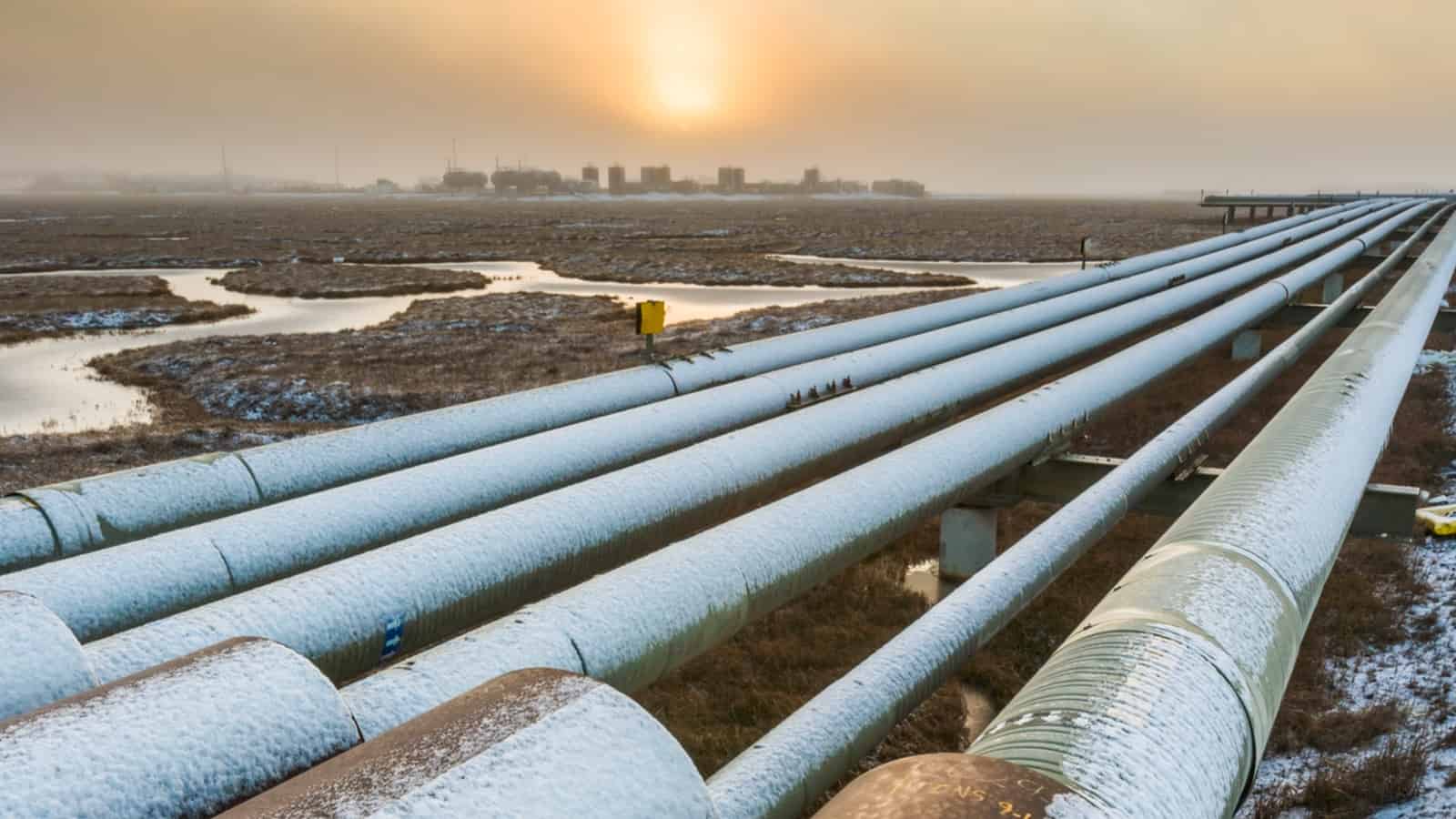
The Biden administration has given its approval of the Willow oil-drilling project in Alaska, reports The Wall Street Journal (subscription).
The gist: “The green light means Houston-based ConocoPhillips can start construction on its roughly $7 billion project in Alaska’s National Petroleum Reserve, which the company expects will produce about 180,000 barrels of oil a day at its peak—equivalent to about 40% of Alaska’s current crude production.”
- “The Interior Department said it would allow drilling on three of the five drill sites proposed by ConocoPhillips, which announced the Willow discovery in 2017.”
The NAM’s take: The NAM expressed its support of the project to the administration last summer, pointing out that while manufacturers make full use of renewable energy sources, they also need oil and gas.
- “Manufacturers know that we must continue developing reliable sources of American energy and can do that in a way that still allows us to achieve critical environmental goals,” said NAM President and CEO Jay Timmons today.
- “The Willow project is one such opportunity, which is why we advocated for its approval. Projects like this strengthen manufacturing’s competitiveness and are essential to bolstering domestic supply chains and job creation.”
NAM in action: The NAM has long been a vocal supporter of enacting permitting reform and making way for large-scale energy and infrastructure projects. Below, you can watch Timmons discuss the importance of overhauling the system during his 2023 State of Manufacturing Address:
The last word: Timmons recently hammered home the need for reform in a message to several U.S. House committees, saying, “Some of the biggest obstacles preventing manufacturers—and therefore the entire American economy—from reaching our full potential are the permitting delays, red tape and complicated bureaucracy that have plagued us for decades.”
Modine Keeps the Digital Economy Cool and Functional
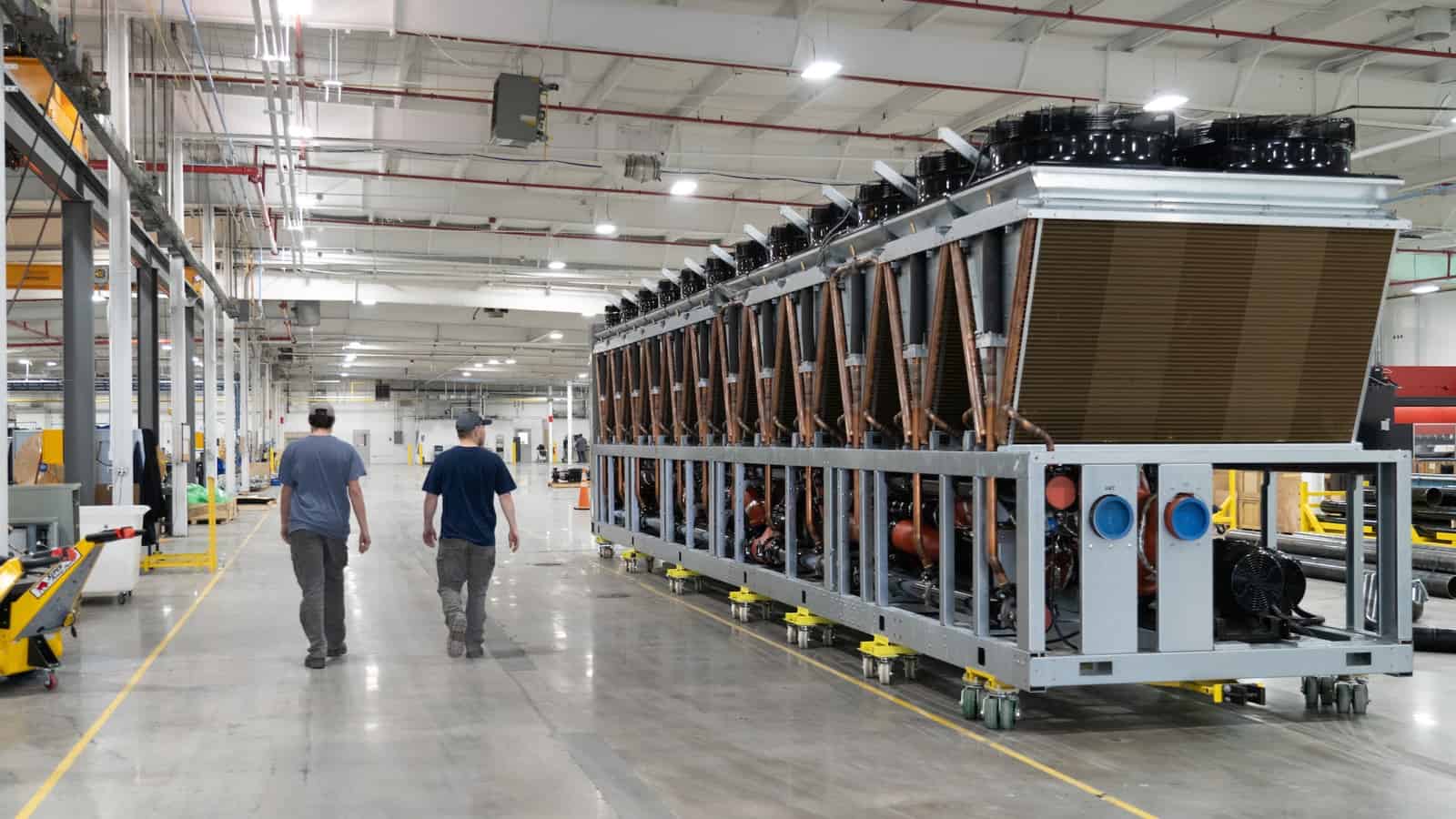
Here’s the secret ingredient in the digital economy: data center chillers. All those enormous data centers that keep track of your bank account, work emails and lunch orders get very hot, requiring state-of-the-art cooling technology to keep them functional and efficient.
We recently got to see how these enormous machines are made, courtesy of Modine Manufacturing, which opened its first data center chiller production plant in Rockbridge, Virginia, back in November. NAM Senior Director of Photography David Bohrer captured the production line in action, while several of Modine’s leaders spoke to the NAM at a later date about the technology involved.
Why chillers? The demand for data center chillers rises with the demand for data, which seems to be pretty much endless nowadays.
- As Darren Farrar, Modine’s global head of marketing for data centers, explained, “Data centers are always on; they are constantly processing data and therefore producing heat. They use a lot of energy, so any incremental improvements we can make [in cooling technology] can make a lot of difference to energy bills.”
- That’s where Modine comes in. Though chillers have been around since the 1920s, the needs of the digital economy mean that further innovation and specialization are always necessary.
How it works: A chiller provides cool water to the data center building while removing the heat that is returned from it, in an endless cycle.
- Modine’s chillers have two circuits, one of which uses outdoor air to chill the water, in a process called “free cooling,” explained Rob Bedard, general manager of data centers, North America. It’s a method that provides considerable energy savings.
- The chiller also has a “classical” refrigeration circuit for when outdoor temperatures aren’t helpful. Last, fans on top of the unit vent heat away from the building.
How it’s made: The Rockbridge plant is Modine’s first data center chiller plant in the U.S. and is situated in Virginia due to the state’s high concentration of data centers, said Bedard. The facility is “purpose-designed” for production, and everything is done on site:
- Technicians cut the parts from raw materials, then add refrigeration, suction and the distinctive V-shaped pipes for coolant, explained Tommy Johnson, Rockbridge’s plant manager.
- The assembly line checks the pressure, ensures there are no leaks and does final testing, he added. The facility even hosts demonstrations for customers in a state-of-the-art test lab, so they know what they’re getting.
Here a team constructs the metal frame of the chiller and adds insulation to the copper pipework and heat exchangers that carry the refrigerant:

Another technician installs the massive fans on top of the structure, which draw air through the huge V-shaped heat exchangers, removing the heat and venting it upward:
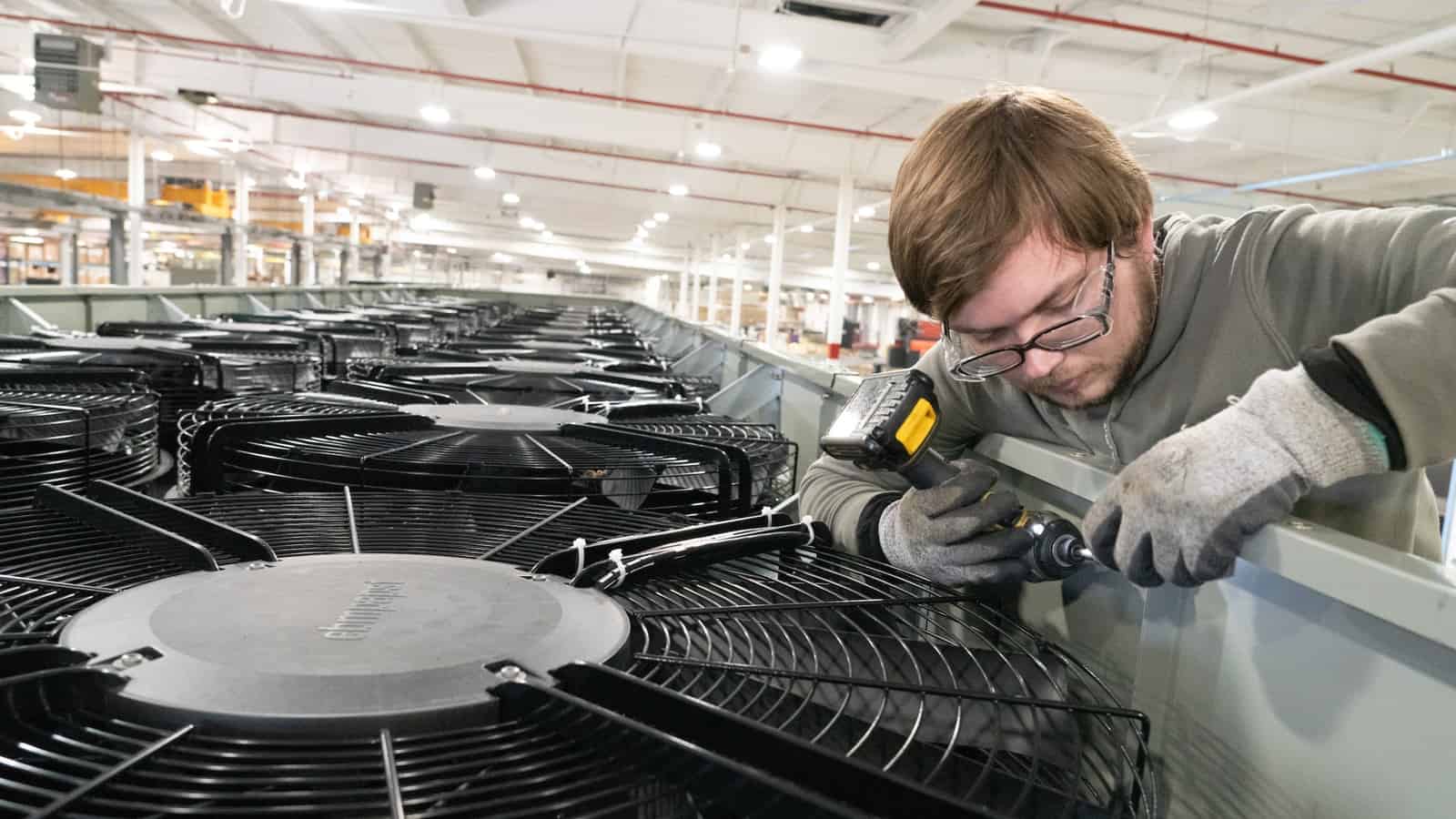
These copper pipes circulate water through the unit:
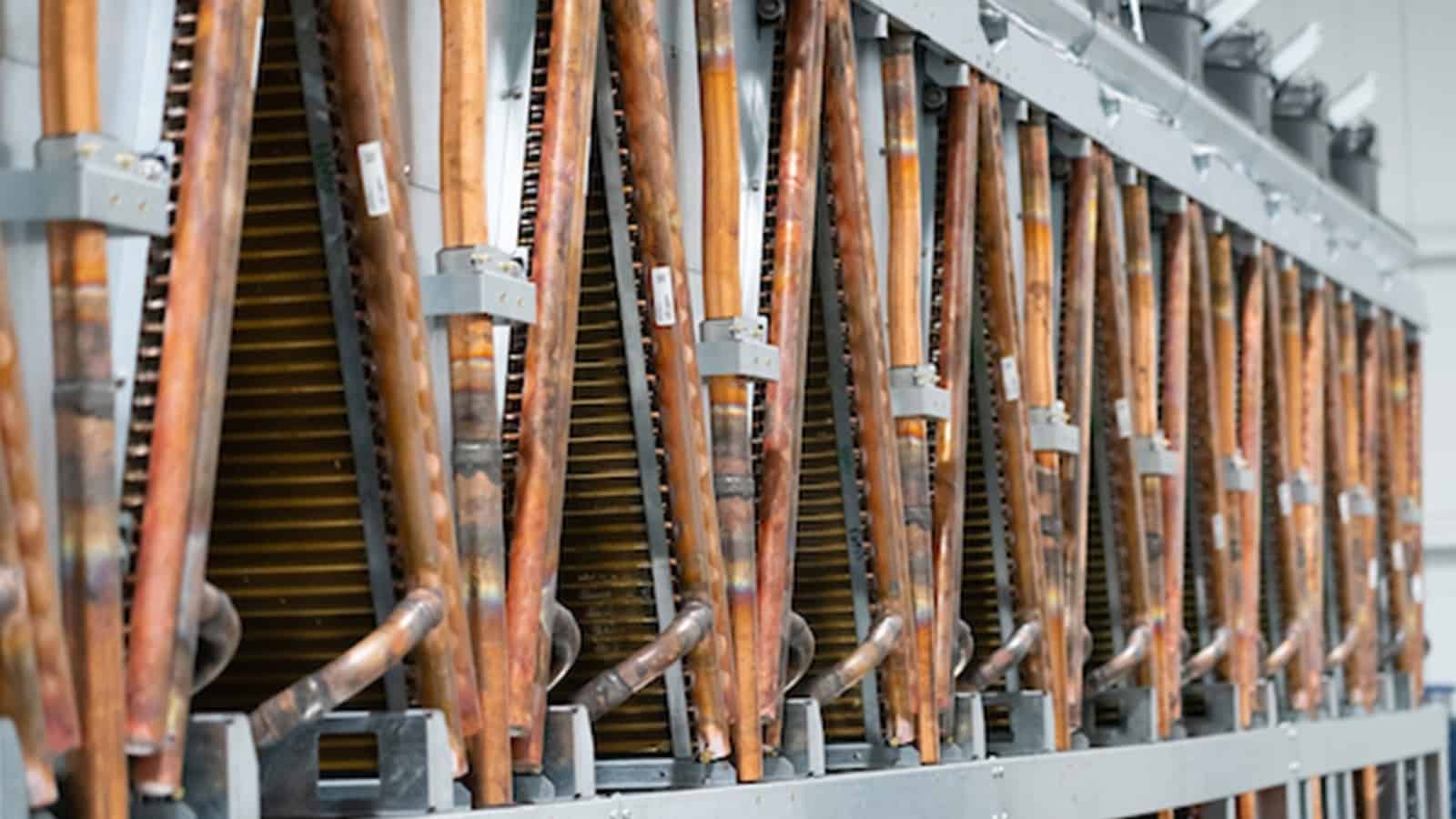
And last, here is the nearly finished chiller, which stands an impressive 10.1 feet tall, 45.6 feet long and 7.8 feet wide:
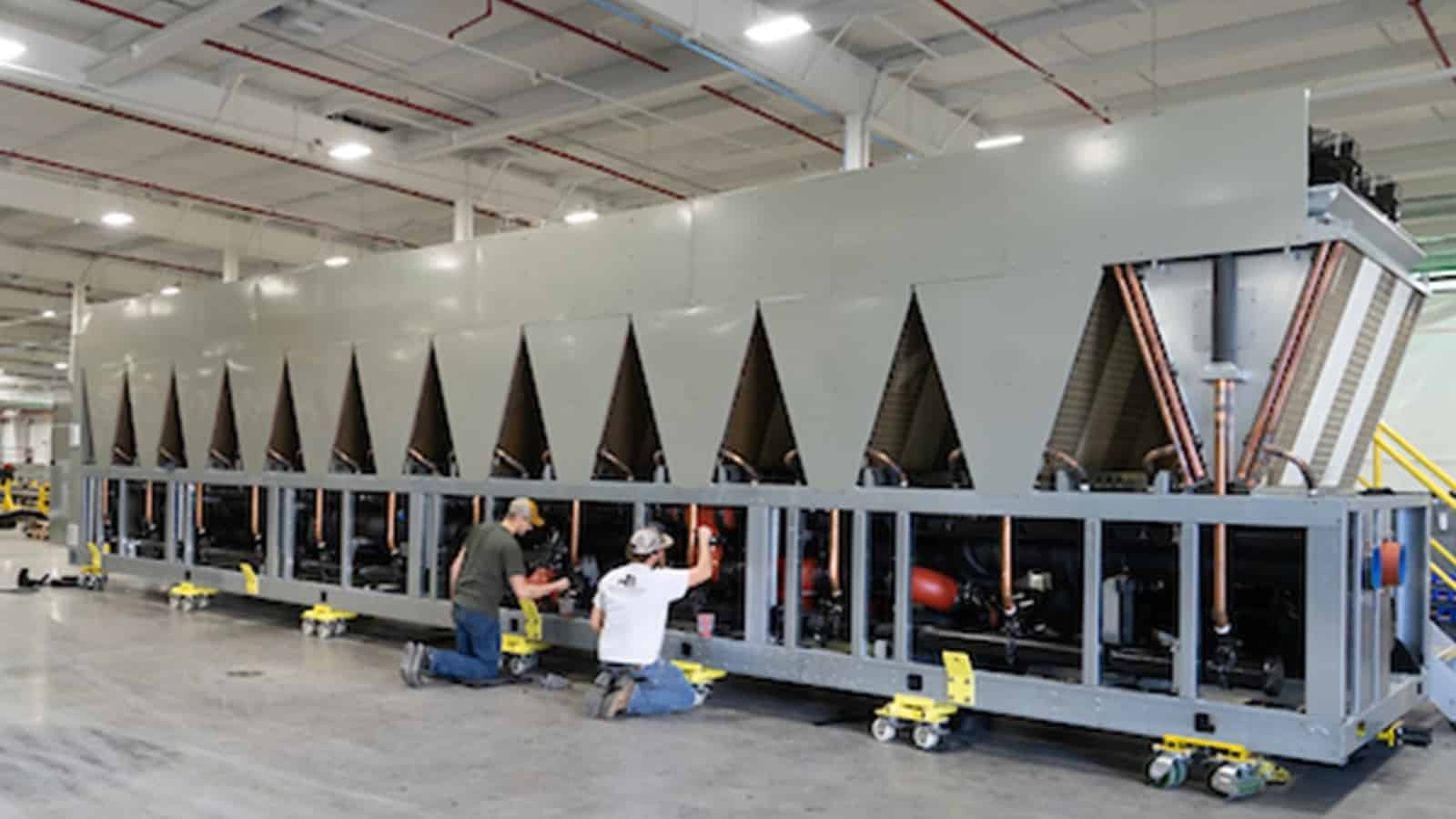
What’s next: What does Modine predict for the future of this market?
- “As big IT companies develop high-density chips,” Farrar said, “existing data centers will only become more powerful—and thus hotter.” Meanwhile, the increasing use of AI and cryptocurrency will also lead to greater demand for data centers.
- In addition, sustainability will only become more of a priority. As Farrar put it, the data chiller industry will have to learn to grow sustainably throughout its supply chain—by using fewer and greener refrigerants, reducing water and carbon usage and more.
- Modine plans to meet these challenges with its newly commissioned testing center at the Rockbridge facility, where it will do all its own testing and validation for the North American market, Farrar said.
Off to a great start: Today, Modine is confident and optimistic, having recently delivered Rockbridge’s first batch of chillers to a Corescale data center in Gainesville Crossing, Virginia. It was “the culmination of all our efforts for a 2-year period,” said Farrar—a real “red letter day.”
“A Catalyst for Change”: Nucor Is All in on Sustainability
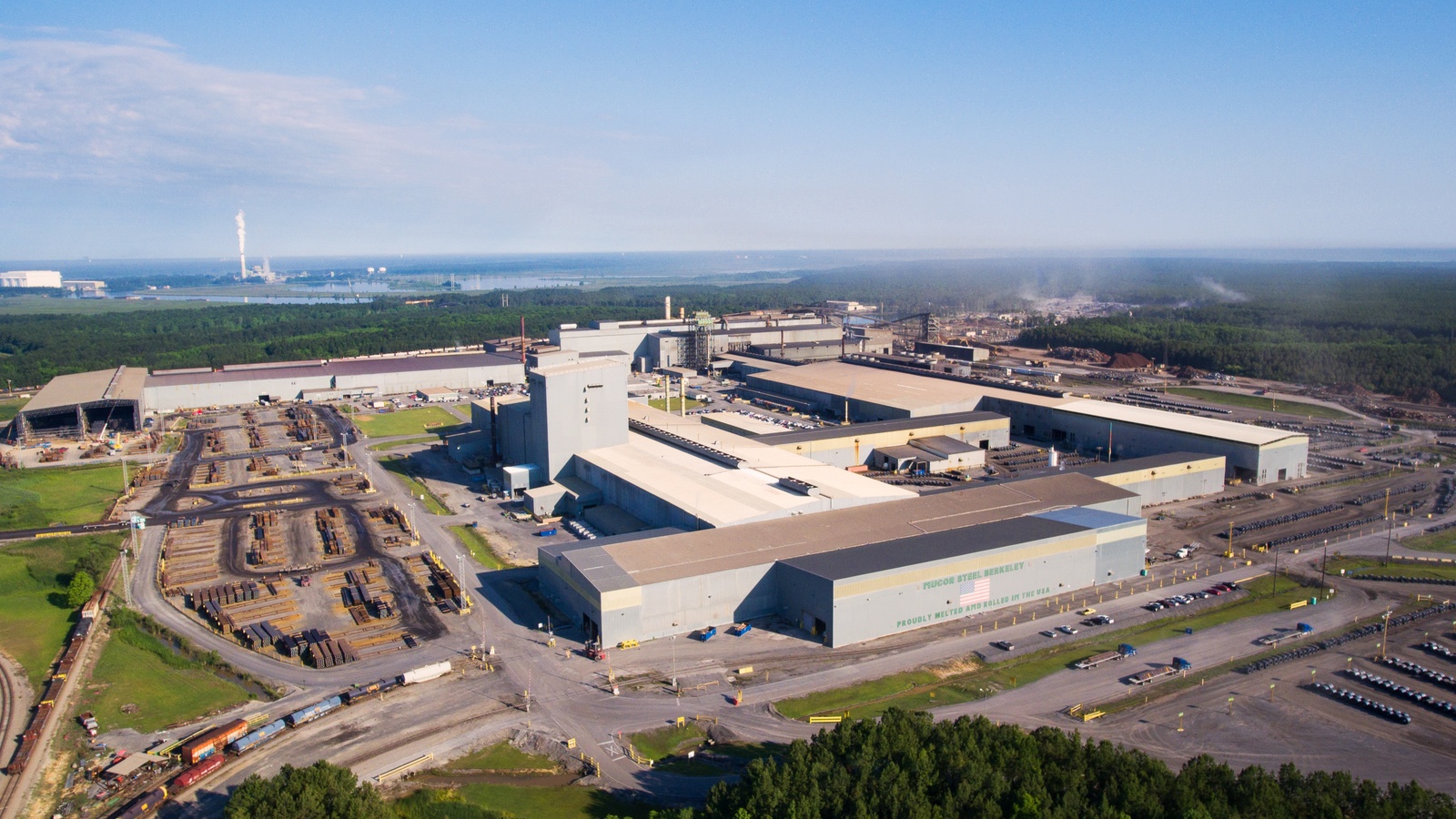
Nucor is one of the cleanest steel companies in the world. Recently, the producer of low embodied carbon steel and steel products committed to further reducing emissions and increasing its global sustainability efforts by joining the United Nations’ 24/7 Carbon-free Energy Compact.
But that’s just the latest in a long list of sustainability initiatives from the company.
Lofty goals: Nucor has committed to a 35% reduction of its steel-mill greenhouse-gas intensity by 2030—no easy feat in the sector, said Nucor Executive Vice President of Business Services and General Counsel Greg Murphy.
- “The levers that companies in this industry can pull depends on the geographic location you’re in, your access to materials and even the geology of the region in which you operate,” Murphy said. “We’re making steel out of recycled content and the fact that we start out with some of the lowest industry greenhouse-gas emissions levels on the planet gives us an advantage.”
- Much of this advantage comes from the company’s use of electric arc furnaces to recycle scrap metal into new steel products, a process Nucor pioneered in the U.S.
- However, EAFs consume large amounts of electricity, making cleaner energy sources an important part of the company’s efforts to reduce emissions. Approximately 40% of the electricity Nucor uses now comes from clean or renewable sources, according to Murphy.
Green upgrades: Nucor is looking at all corners of its operations for ways to reduce and improve.
- The company is building a new rebar “micromill” (its third in the past five years) to make rebar for infrastructure and construction projects. Micromills eliminate the need for reheat furnaces, further reducing Nucor’s use of natural gas.
- Nucor is also considering replacing charge and injection carbon—two solid-carbon sources used in its furnaces—“with recycled and wood components, which would significantly reduce emissions,” Murphy said.
- In addition, the steel manufacturer is investing in ways to extract nonferrous materials, such as copper, from obsolete scrap. More reuse means a smaller carbon footprint, according to Murphy.
- Finally, the company is exploring the use of carbon capture and sequestration at one of its facilities and is investing in alternative iron-making technologies that would enable it to produce carbon-free, high-quality iron.
Bringing in nuclear: Nucor takes an all-of-the-above approach to energy, which is what will allow it to fulfill the goals of the U.N. compact, according to Murphy.
- “A fundamental premise of [the compact] is that access to affordable, clean energy is essential to the world’s sustainable future,” Murphy said. “That’s one of the things that really attracted us to it—this emphasis on not just providing renewable energy, but providing affordable, reliable and clean energy. That’s not only solar and wind, but also geothermal, hydroelectric and, critically, nuclear. We think that all of these forms of clean energy have a role to play.”
- Last year, Nucor invested in NuScale Power, a company developing small modular nuclear reactors. The U.S. Nuclear Regulatory Commission recently approved the design and the first operational reactor is expected by the end of this decade.
The final word: “At the end of the day, the sustainability issue is not going to go away,” Murphy said. “It’s here to stay, and I think companies can either move in this direction kicking and dragging their feet, or they can do it with leadership. The developed world needs to lead the developing world. We need to be a catalyst for change.”
Energy Manufacturers Need Policy Support

As the world’s leading energy producer, the U.S. is poised for long-term energy independence and competitiveness in the global marketplace—but only with the right policies in place.
The right recipe: That’s the theme of the NAM’s energy and natural resources advocacy in its policy blueprint, “Competing to Win,” and it’s the recipe for continued success for all manufacturers in the U.S.
- Manufacturers lead the way in finding new means of harnessing our abundant sources of energy, but to make long-term investments and continue to innovate, policymakers should draw up and stand by a comprehensive framework for a secure energy future.
Keep us competitive: The NAM calls on legislators to take specific actions to keep energy manufacturing in the U.S. competitive. These include:
- Streamlining regulations that slow access to our rich supply of energy, minerals and other natural resources;
- Expediting the regulatory and legal processes involved in developing clean energy technologies and promoting energy and energy technology trade;
- Fixing the broken permitting process for energy production and infrastructure projects;
- Promoting access to federal lands and waters for environmentally responsible mineral, energy and resource exploration;
- Supporting measures to enhance development and deployment of energy-efficient technologies;
- Backing domestic critical mineral extraction, recycling and processing; and
- Expanding the useful life of critical minerals components using federal programs and funds.
Focus on the environment: Energy produced in the U.S. is cleaner and more responsibly sourced than energy produced in other nations.
- When U.S. policies fail to encourage production here at home, they encourage production in other parts of the world, where there is far greater adverse impact to the environment.
Security through innovation: Sound, thorough and competition-focused energy policy will give energy manufacturers in the U.S. the stability they need to invest for the long term.
- Innovation, energy security and greater affordability—not just for the U.S., but for other countries as well—will follow.
The last word: “The future of the manufacturing industry and our country’s resource security rely on clarity and certainty from policymakers that strengthens our competitiveness,” said NAM Vice President of Energy and Resources Policy Rachel Jones.
- “With a renewed commitment to increasing domestic energy production and delivery, to focusing on critical mineral and material supply chains and to advancing new technologies, the United States can continue to lead the world for decades to come.”
Manufacturers: A Windfall Profits Tax Would Be a Dangerous and Destructive Policy
Washington, D.C. – Following President Biden’s call for a windfall tax on America’s energy producers, National Association of Manufacturers President and CEO Jay Timmons released the following statement:
“Raising taxes on American energy manufacturers is dangerous and destructive for the American people and the manufacturers who depend on access to reliable energy. It would disrupt domestic supply at a time of severe geopolitical uncertainty. Indeed, history has shown that this is a failed policy that could lead to more imports and even higher prices.
“Manufacturers have provided real solutions and specific recommendations for improving energy security and taking an all-of-the-above approach to developing all forms of American energy. Manufacturers will continue doing everything in our power to be part of the solution, and we hope our elected officials will too.”
-NAM-
The National Association of Manufacturers is the largest manufacturing association in the United States, representing small and large manufacturers in every industrial sector and in all 50 states. Manufacturing employs more than 12.9 million men and women, contributes $2.77 trillion to the U.S. economy annually and accounts for 58% of private-sector research and development. The NAM is the powerful voice of the manufacturing community and the leading advocate for a policy agenda that helps manufacturers compete in the global economy and create jobs across the United States. For more information about the NAM or to follow us on Twitter and Facebook, please visit www.nam.org.
Operating on Sunshine: Sealed Air Invests Big in Solar
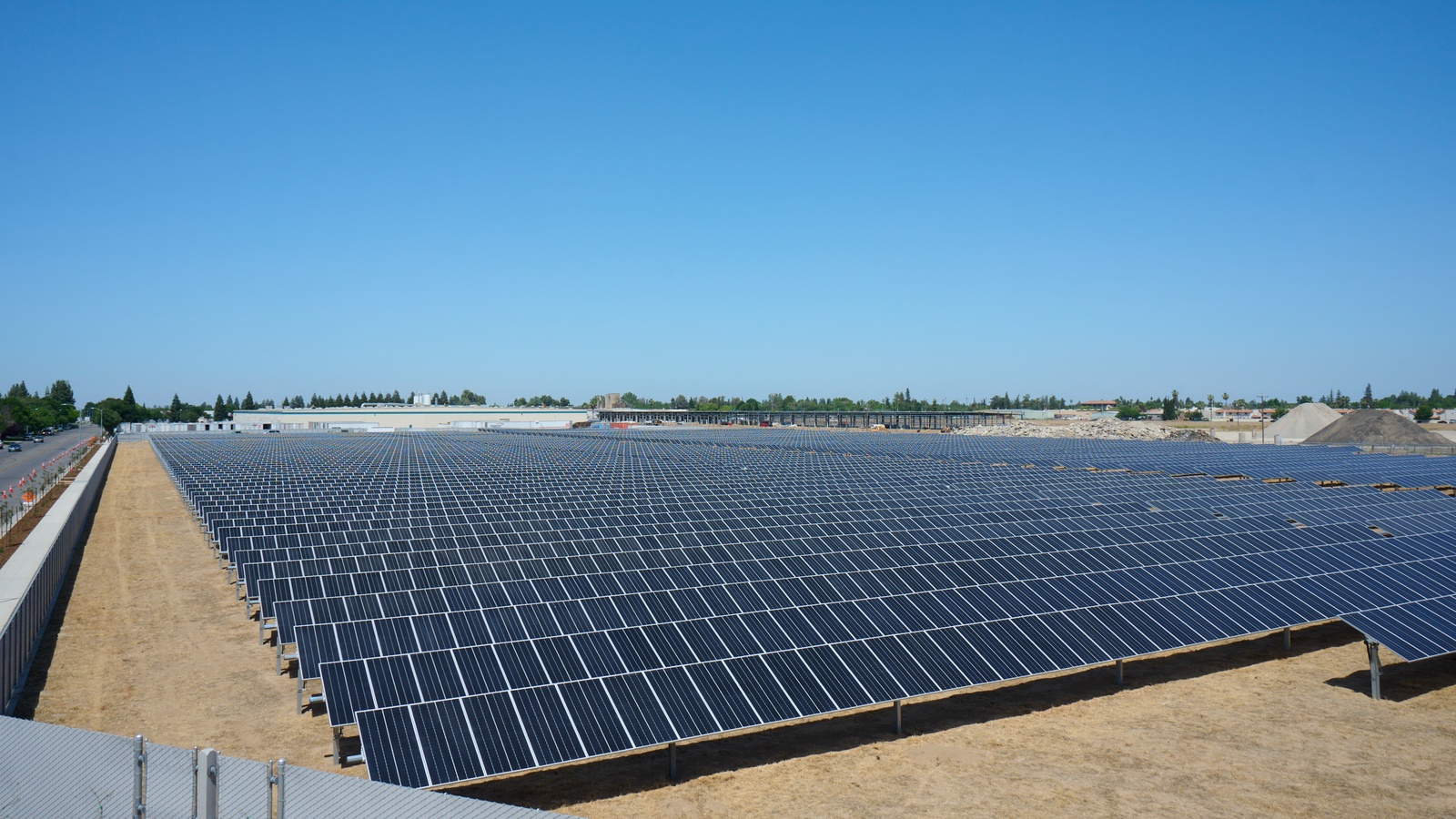
For Sealed Air Corporation, the $1 million annual savings it will realize from its recent investment in an 11-acre solar farm is just a perk that goes along with doing what’s right.
Toward a goal: “We always have sustainability in mind with everything that we do, whether it is a new product or a new facility,” said Sealed Air President of the Americas Tobias Grasso. “We always ask, ‘What is this bringing to us?’ and ‘How is this advancing our mission to leave our world better than we found it?’ Because we have a stated goal to be net-zero carbon neutral in our operations by 2040, we want to make sure that all our investments are in line with that strategy.”
- Earlier this year, a $9 million solar installation at Sealed Air’s Madera, California, manufacturing facility began generating electricity—at a rate capable of fulfilling 98% of the plant’s electricity needs, according to company calculations.
- The solar farm is integrated into the legacy power system so that system has a backup energy source when needed.
The right site: Sealed Air, the maker of the iconic Bubble Wrap® original cushioning and numerous other automation, packaging and digital printing solutions, started making plans for the 8,975-solar-panel farm in 2020. It chose the Madera location as the site for several reasons.
- “We have fairly extensive energy needs for that facility,” Grasso said. “And we had the available land and a good number of hours [of available sunlight] to provide the solar energy.”
- The manufacturer partnered locally with a team from TotalEnergies—a French company that recently acquired SunPower Commercial and Industrial Solutions—on the project.
The impact: Though the company got its solar installation up and running in less than two years, its effect on the environment will be long-lasting and far-reaching.
- The solar panels will prevent 5,000 metric tons of carbon dioxide emissions in just their first year in operation.
- Over the course of 15 years, that’s the greenhouse gas emissions equivalent of driving 15,000 cars for one year, Grasso said.
Solar-power advice: Manufacturers with the right energy needs, land and daily hours of sunlight could benefit from investment in their own solar installations, according to Grasso.
“First, you have to look at the dimensionality of your power needs; you have to look at the economics,” he said. “It’s a good idea to have a partner like TotalEnergies because they can help you through their experience so you model it the right way.”
Manufacturers: Court’s Decision Affirms EPA’s Authority to Issue Appropriate Greenhouse Gas Regulations
Washington, D.C. – Following the Supreme Court’s 6–3 decision in West Virginia vs. EPA, National Association of Manufacturers President and CEO Jay Timmons released the following statement:
“Manufacturers share a deep commitment to protecting our planet and our people, and manufacturing innovation holds the key to solving the generational challenge of climate change. The court’s decision affirms the Environmental Protection Agency’s authority to issue appropriate greenhouse gas regulations while providing a reminder that the agency must stay within the guardrails delegated by Congress. As some of the largest electricity consumers and as electricity generators, manufacturers are ready to work with the EPA to deliver innovative and balanced solutions that protect our environment and our competitiveness as it considers next steps.”
Background: Earlier this week, the NAM along with 42 state partners sent President Biden a letter highlighting the importance of affordable, reliable electricity for manufacturers to remain competitive. It signals manufacturers’ eagerness to work with policymakers on the important decisions and planning surrounding the future of the electrical grid and broader energy policy.
-NAM-
The National Association of Manufacturers is the largest manufacturing association in the United States, representing small and large manufacturers in every industrial sector and in all 50 states. Manufacturing employs more than 12.7 million men and women, contributes $2.71 trillion to the U.S. economy annually and accounts for 58% of private-sector research and development. The NAM is the powerful voice of the manufacturing community and the leading advocate for a policy agenda that helps manufacturers compete in the global economy and create jobs across the United States. For more information about the NAM or to follow us on Twitter and Facebook, please visit www.nam.org
Manufacturers Warn Gas Tax Suspension Is a Step Backward
Washington, D.C. – Following the decision by President Biden to instruct Congress to suspend federal gasoline and diesel taxes for three months, National Association of Manufacturers President and CEO Jay Timmons released the following statement:
“Our nation achieved historic progress with the Bipartisan Infrastructure Law, but this move is likely to derail its implementation by suddenly disrupting its funding, delaying critical projects that Americans desperately need and that are vital to manufacturers’ competitiveness. Our focus should be on increasing energy production here at home—to make manufacturers more competitive, to bring energy and gasoline prices down and to provide lasting relief for American families. We need the same smart, long-term approach that inspired the infrastructure bill to solve today’s energy challenges.
“Since the beginning of this administration, we have provided specific solutions and recommendations for improving energy security and taking an all-of-the-above approach: restarting and expanding oil and gas leasing on federal lands, prioritizing funding and expediting permitting for traditional and emerging energy options, expanding critical mineral mining and processing, strengthening and diversifying clean energy supply chains, promoting regulatory predictability by refraining from revising air standards until previous ones are met, upholding the infrastructure law’s One Federal Decision policy and more. We would be in a better position now if these and other actions had already been taken, and the need to act has only grown more urgent. Manufacturers will continue doing everything in our power to be part of the solution.”
-NAM-
The National Association of Manufacturers is the largest manufacturing association in the United States, representing small and large manufacturers in every industrial sector and in all 50 states. Manufacturing employs more than 12.7 million men and women, contributes $2.71 trillion to the U.S. economy annually and accounts for 58% of private-sector research and development. The NAM is the powerful voice of the manufacturing community and the leading advocate for a policy agenda that helps manufacturers compete in the global economy and create jobs across the United States. For more information about the NAM or to follow us on Twitter and Facebook, please visit www.nam.org.
World’s Largest Floating Wind Farm Could Become Reality

Energy company Equinor, in partnership with ConocoPhillips, Shell and Total, is looking into the possibility of building the world’s largest floating offshore wind farm, according to POLITICO Pro’s CLIMATEWIRE (subscription).
What’s going on: Equinor said that “Trollvind,” which would be constructed off the coast of Bergen, Norway, “would have an installed capacity of about 1 gigawatt and would produce 4.3 terawatt-hours annually.”
- “The companies are aiming to make the installation economically feasible by buying as much energy as it produces and are targeting a final investment decision next year to bring the installation online in 2027.”
Why it’s important: The announcement comes as many energy companies look increasingly to offshore wind, which is set “to develop rapidly through the end of the decade.”
- Floating offshore installations such as the planned Trollvind allow for energy harvesting in deep waters where installing fixed-foundation turbines is not feasible, opening up many more areas of the water to wind capture.
- “The Global Wind Energy Council (GWEC) forecasts that floating offshore wind capacity will reach 16.5 GW by 2030, according to a recent report published by GWEC and sponsored by Shell.”
A call to U.S. action? “This continued advancement begins unlocking the technology and supply chain to build the new industry,” Business Network for Offshore Wind Director of Coalitions and Strategic Partnerships Sam Salustro told the publication.
- “[T]here is still a need for coordination between the states and federal government to ensure we have the infrastructure to support floating [wind] and can support our suppliers.”
- The West Coast leads the U.S. in floating wind-farm development.
The NAM’s take: “This announcement is part of a much larger trend we are seeing in the U.S. and around the globe,” said NAM Director of Energy and Resources Policy Chris Morris. “The NAM has been a leader in ensuring all states that want to pursue offshore wind options can. Earlier this year, we urged policy makers to repeal the 10-year moratorium on offshore wind leasing off the coasts of North Carolina, South Carolina, Georgia and Florida. We will continue to push for policies that provide diverse, secure energy options for manufacturers.”
